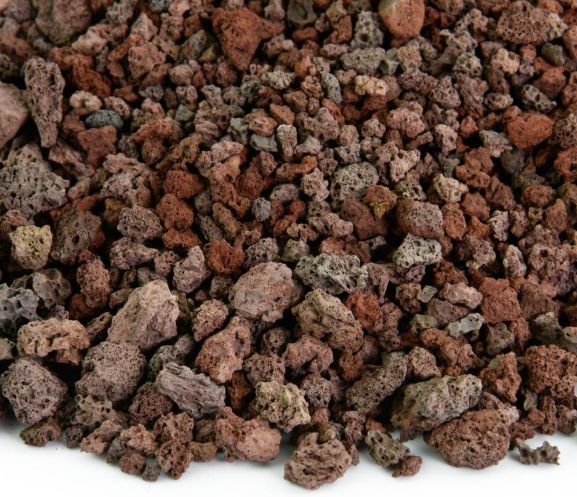
Lava rock has a very convoluted surface which we initially thought would mean it must be doubled in surface area calculations. This turned out not to be true.
Lava rock is best used in aquariums in the range of ¼ to ½ inch diameter. You can get small lava rock from the internet. Joey (the King of DIY aquariums) recommends just using a hammer to take large lava rock to half an inch.
Many folks on FaceBook use lava rock in the same size as it comes from the garden shop, typically two to three inches in diameter. This is far too big of a media to be an effective biomedia. These larges size rocks must be broken up.
Lava rock is just pumice or perlite with a bigger pore size and thicker rock walls. It doesn’t float so it can be used in all submersed static media bed filter designs. Since it is a crushed rock product it does shed tiny microscopic particles which can destroy the impellers in an aquarium pump.
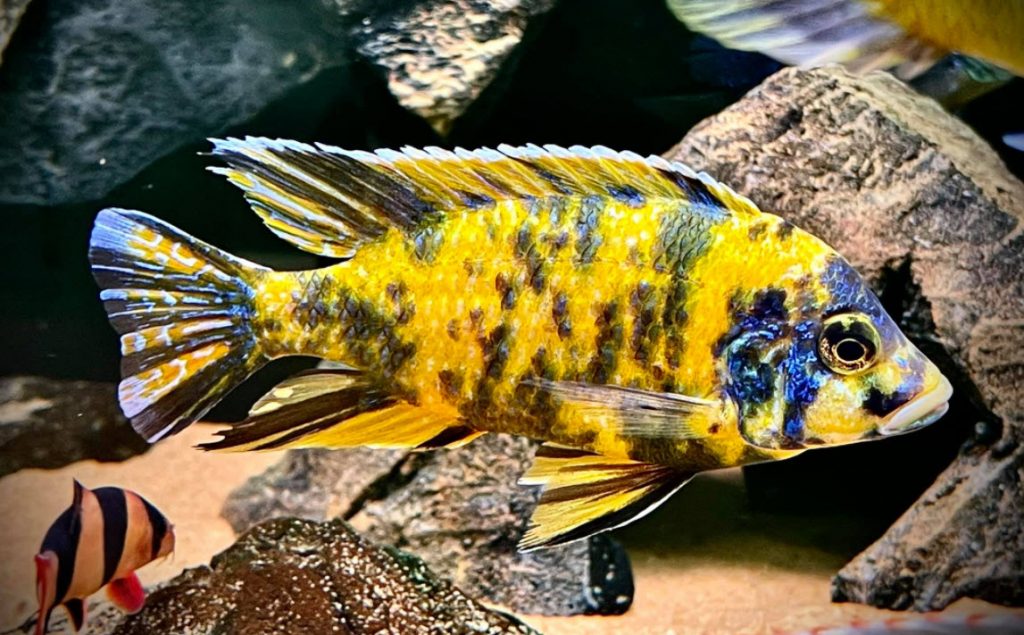
Testing of Lava Rock
When tested half inch lava rock did not do well when it came to ammonia oxidizing capabilities. This was quite honestly very surprising. We did not expect lava rock to perform this poorly.
A test of ammonia oxidizing capability of various filter media was run. The first number, the “efficiency” is the average ammonia oxidizing that 15 cubic inches of media accomplished over a 90-day period. The second number is the “effective” surface area in square feet per cubic feet calculated from that test. The third number is the effective surface area in square feet per cubic feet calculated by simple mathematics. The correlation between the test results and the calculated surface area is very significant and means the testing was accurate.
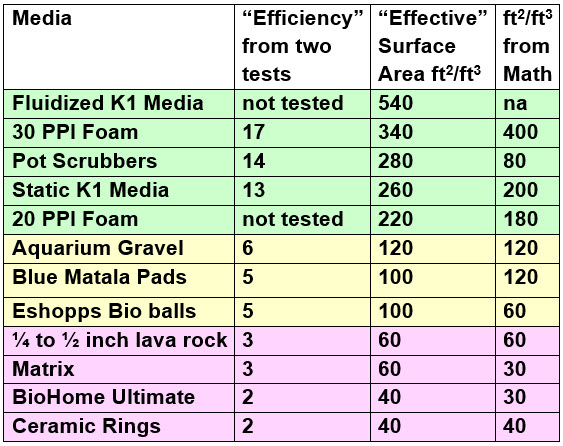
The higher the numbers here the better the media. Lava rock did not do too well. This test can be found in this article:
7.1.3. Test of Filter Media
Lava rock is just a porous natural ceramic product. As such it shares all the shortcomings of porous ceramic media. A write up on these shortcomings can be found in this article:
7.2.11. Ceramic Filter Media
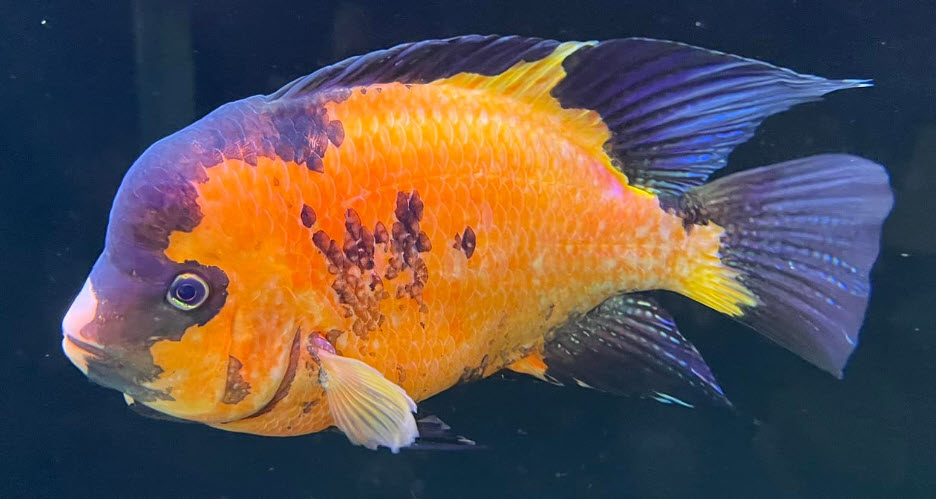
Lava Rock Does NOT Remove Nitrate
There are websites (aquaessentials.co.uk and Aquariumfish.net) which claim the following about lava rock in an aquarium:
“You only have to inspect the rock and you can see it is covered in tiny holes making it extremely porous allowing water to pass through and diffuse into the rock. So what does The Hidden Benefits of Lava Rock really mean? An anaerobic environment is created inside the rock as beneficial nitrifying bacteria consume all the oxygen in the water. Within this anaerobic environment inside the rock, denitrifying bacteria consume the nitrate and produce oxygen and nitrogen. We all know how nitrate in the aquarium is bad news for fish and shrimp so lava rock really is the most natural and best way of removing nitrate.”
I can’t sugar coat it. This statement is pure and simple hogwash. Note that the term “lava rock” in this quote is linked to website that sells lava rock. Click on the link, buy some lava rock and the website gets a commission. Don’t you just love the profit motive?
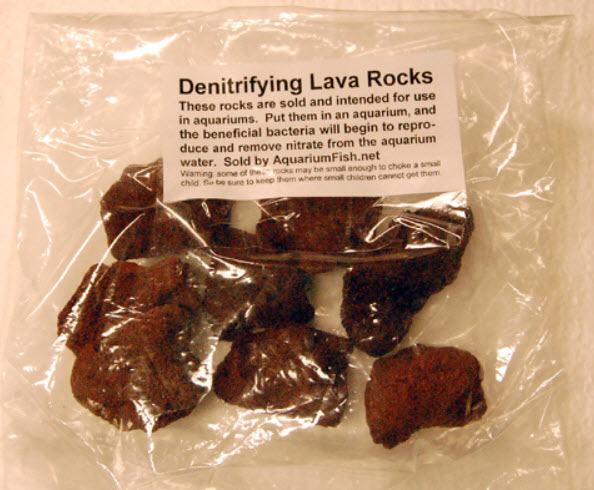
Again, let me emphasize, lava rock categorically does absolutely NO removal of nitrates to nitrogen gas. It is completely and totally impossible. We tested two products with similar “microporosity” as lava rock (BioHome and De*Nitrate) and found no denitrification took place over the span of one year. This test can be viewed at this link:
7.5. Test of Denitrifying Media
.
Return to Filter Media Menu
Return to Media List Menu
.
Aquarium Science Website
The chapters shown below or on the right side in maroon lead to close to 400 articles on all aspects of keeping a freshwater aquarium. These articles have NO links to profit making sites and are thus unbiased in their recommendations, unlike all the for-profit sites you will find with Google. Bookmark and browse!
.

Tim says
Hi.
I have read the testing of different medias with great interrest. And as a result im changing my filters to 30/35ppi foam. I use a prefilter to avoid premature clogging.
But there is one paragraph i cant wrap my head around. You write this about the 2″-3″ Lava rock from garden suppliers. “It has a surface area of around 2 square foot per cubic foot”. How is this possible? How can the surface be less than an equivalent solid 1 square foot cube? Given that smaller lava rocks are given at 60 square feet / square foot i would have thought 20 square feet for the larger version would be realistic. Is it a simple typo?
Best regards.
Dave says
In reply to Kass ….. The pores in the lava are much too small. Because they are so small, as for nitrification (ammonia to nitrate):
1, In most of the pores beneficial bacteria can’t even fit.
2, The pores that beneficial bacteria can fit in are still small enough that a few divisions of the bacteria render the pore useless
3, Flow is around the pores, not through the pores.
4, This was confirmed by testing.
“Denitrification” (nitrate to nitrogen gas) does not go on ANYWHERE in ANY aquarium and ANY media.
Kass says
I would like to read more about why lava rock does not remove nitrates. Are we supposed to just look at the chart above? Can you elaborate why the porous nature of lava rock does not house as much beneficial bacteria as gravel? It’s difficult to understand why aquarium gravel is better.